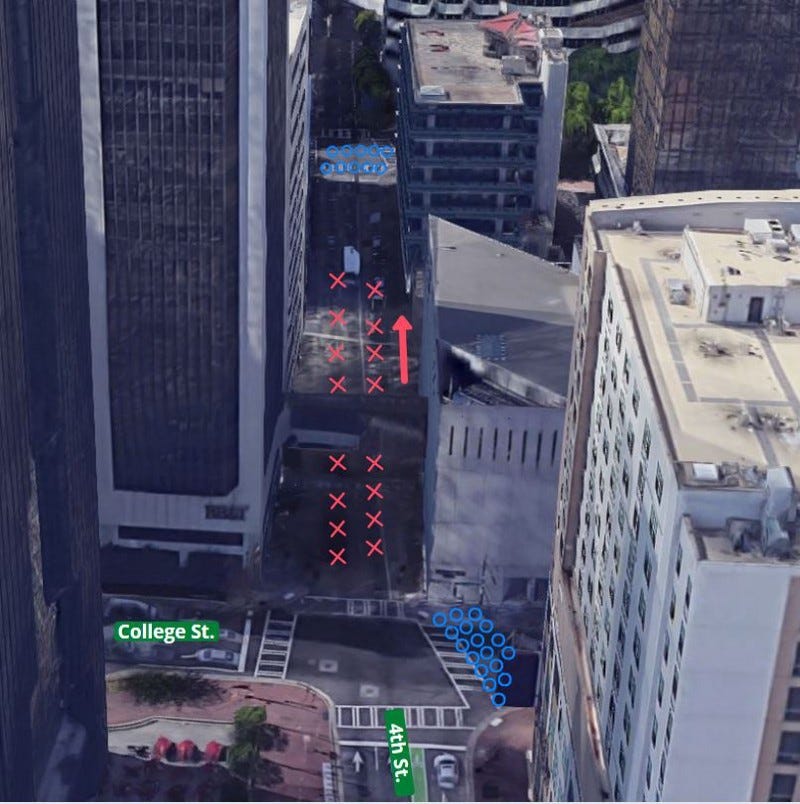
SCOPE OF REVIEW
Late in the evening of June 2nd, several of my constituents contacted me regarding an incident that had just occurred in uptown Charlotte, which is part of the state Senate district I represent.
I watched this video, captured by Queen City Nerve, a local news organization.
I thought the video raised serious concerns, so I told my constituents that I would do the following:
- Meet with the Mecklenburg legislative delegation to discuss and coordinate next steps, as many of them had similar concerns.
- Speak with constituents who were present for the incident.
- Speak with CMPD and hear their account.
- Speak with members of Charlotte City Council to get their perspective, as they are the ones who directly oversee local law enforcement and are more familiar with police policy.
I did those things. I also reviewed all publicly available information that I could find and read all the news reports about the incident.
It’s important to note that three formal reviews of this incident have been initiated by the State Bureau of Investigation (S.B.I.), the Center for Domestic Preparedness (a federal agency focused on developing and promoting best practices regarding police policy), and CMPD (with all documents to be turned over to the Charlotte Civil Board, which is a citizen oversight board).
We don’t know how long any of these reviews will take, but the S.B.I. review — which will be the most comprehensive — will likely take at least a month.
While a comprehensive review is necessary, we also need an expedited review given the ongoing nature of the protests. In short, we should not have to wait a month to figure out the basics of what happened here.
Accordingly, the timeline that follows is based on information available as of June 8th.
5:00–9:03 p.m.
On 5:00 p.m. on June 2nd, the NAACP of North Carolina organized a protest in response to the killing of George Floyd to take place in Charlotte, North Carolina.
Despite being the fifth consecutive day of protests, turn-out was still high with roughly 4,000 people in attendance.
The starting point for the march was the Charlotte-Mecklenburg Government Center, at which several speeches were given. The march then proceeded through Uptown Charlotte.
Here’s a look at the crowd at roughly 5:45 p.m.:
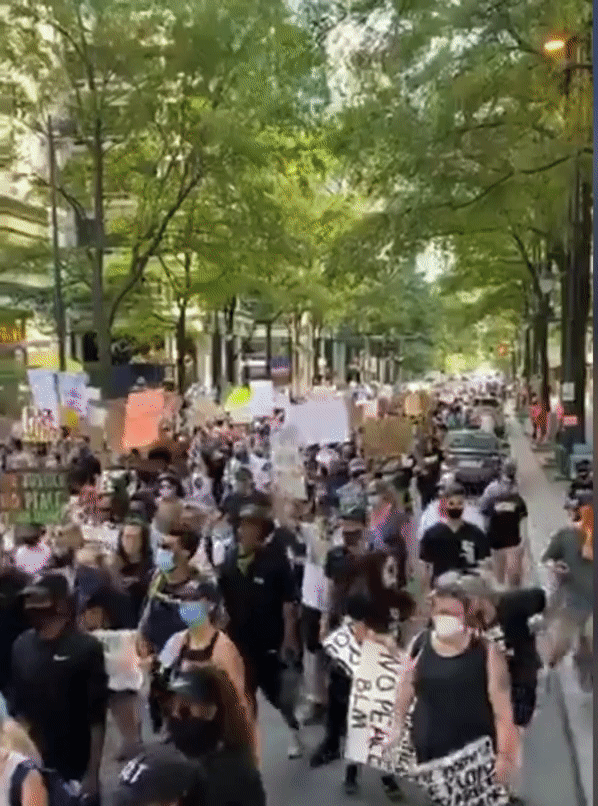
At approximately 6:00 p.m., the march convened at CMPD Headquarters. Police presence appears to have been minimal. Several speeches were given. There appear to have been no incidents at this location.
Here’s what it looked like:
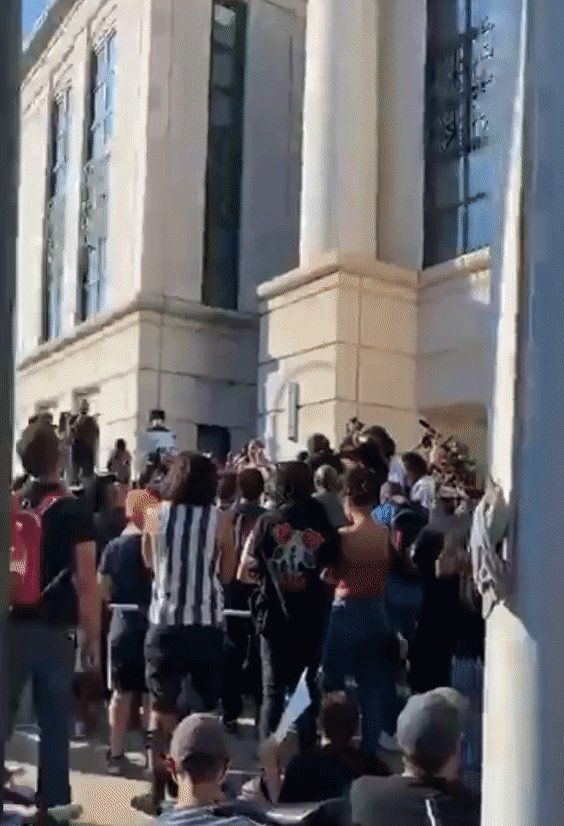
After roughly 20 minutes, at approximately 6:20 p.m., the march continued.
By 8:10 p.m., the march arrived at Romare Bearden Park. After over three hours of marching, the crowd had shrunk to roughly 800 people.
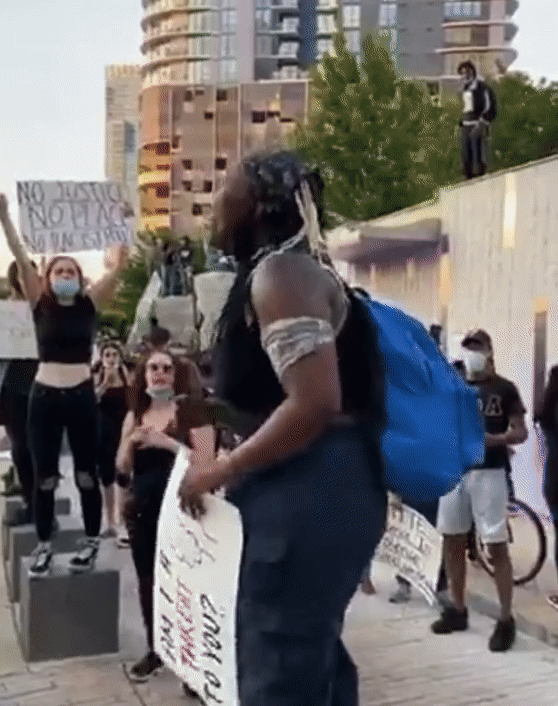
Roughly one hour later, at approximately 9:00 p.m., roughly 350 remaining protesters marched east down 5th Street until they reached the intersection of 5th Street and McDowell Street.
Here, a row of CMPD officers with bicycles were dismounted and arranged to block the far side of the intersection, so as to prevent the protesters from continuing onto Independence Boulevard. We don’t know if that was the intent of the protesters at that time (or whether any specific intent existed at all by that point), but this blocking maneuver was designed to ensure it didn’t happen.
At approximately 9:03 p.m., tear gas was detonated for the first time that evening.
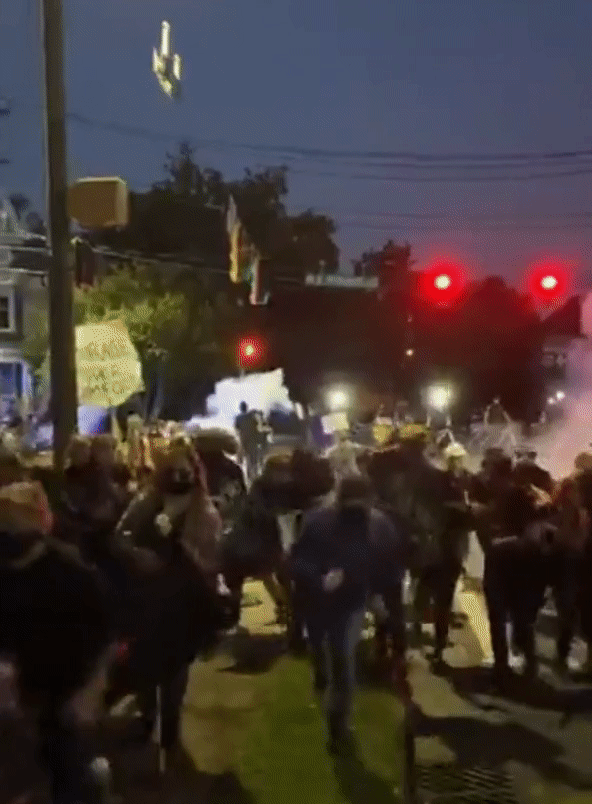
CMPD states that it was at this location that one or more of its officers were assaulted with some form of projectile. CMPD has requested all body camera footage from this evening and that request is currently pending in court (more on this process below).
CMPD also states that on or about this time, it gave several dispersal orders to the protest. Body camera footage may support that claim, but it is worth noting that in the live-stream provided by Queen City Nerve (from which I have been using clips), at no point can a dispersal order be heard. I invite you to spend some time watching the video, which can be found here. It may be possible that a dispersal order was in fact given and simply not heard by many of the protesters, but of the several protesters with whom I spoke — which included a local clergyman and a local doctor — none of them told me that they heard a dispersal order.
CMPD Dispersal Policy
At this point, I need to explain something about CMPD policy with respect to handling protests.
If certain individuals within a group of protesters become assaultive toward CMPD, it is CMPD’s stated policy to try to identify and detain those individuals without declaring the entire protest unlawful. I have seen CMPD be successful in this, separating and detaining certain individuals while letting the crowd proceed.
However, if CMPD feels it is unable to identify the particular individuals or feels that a general threshold of combativeness on the part of the protesters has been reached, CMPD will declare the entire protest unlawful — at which point tactics shift from “accommodating” the protest to “dispersing” the protest.
This point is very important: Once a protest is deemed unlawful, it is unlawful for the rest of the night, no matter how the crowd acts from that point forward or how much time goes by without incident.
That means once a crowd has been deemed unlawful, you could theoretically have entirely lawful conduct by the crowd with virtually no interaction with law enforcement, only to be surprised an hour or two later by sudden, highly coordinated, aggressive dispersal tactics in a completely different part of the city, all stemming from the original declaration of the crowd as unlawful earlier that evening.
9:03–9:29:50 p.m.
After the tear gas detonation at the intersection of 5th Street and McDowell Street, there was a tense standoff with law enforcement for several minutes, at which point the protesters turned back and began marching uptown.
At approximately 9:28 p.m., the remaining 350 protesters approached the intersection of 4th Street and College Street.
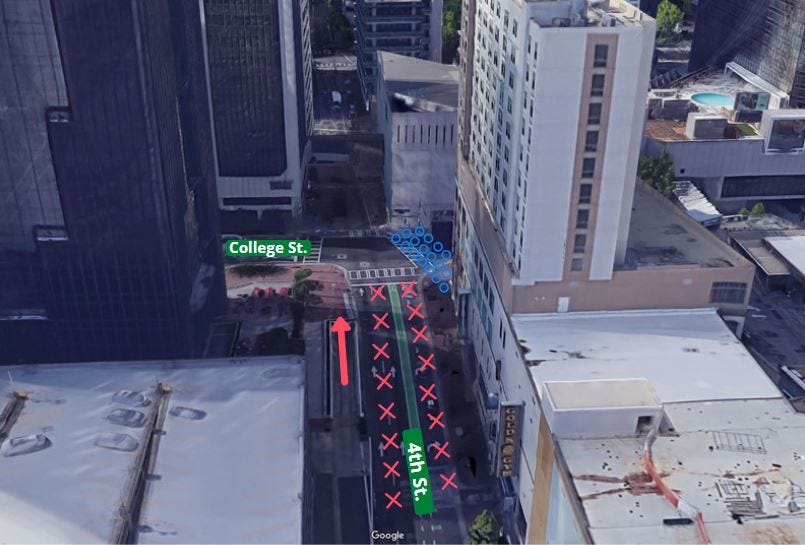
As they marched through the intersection, roughly fifty police officers stood to their right, precluding a right-hand turn onto College Street.
Here is what it looked like from the perspective of the protesters:
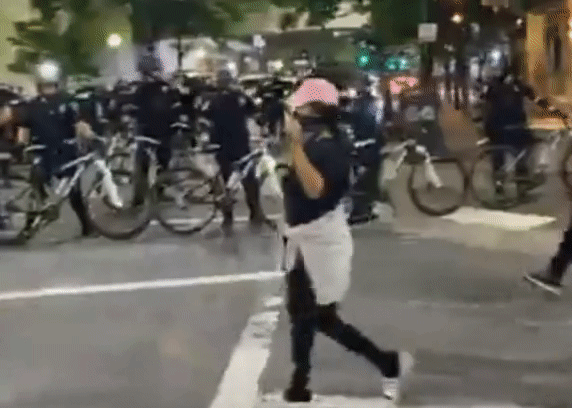
All of the protesters made it through the intersection, as depicted below:
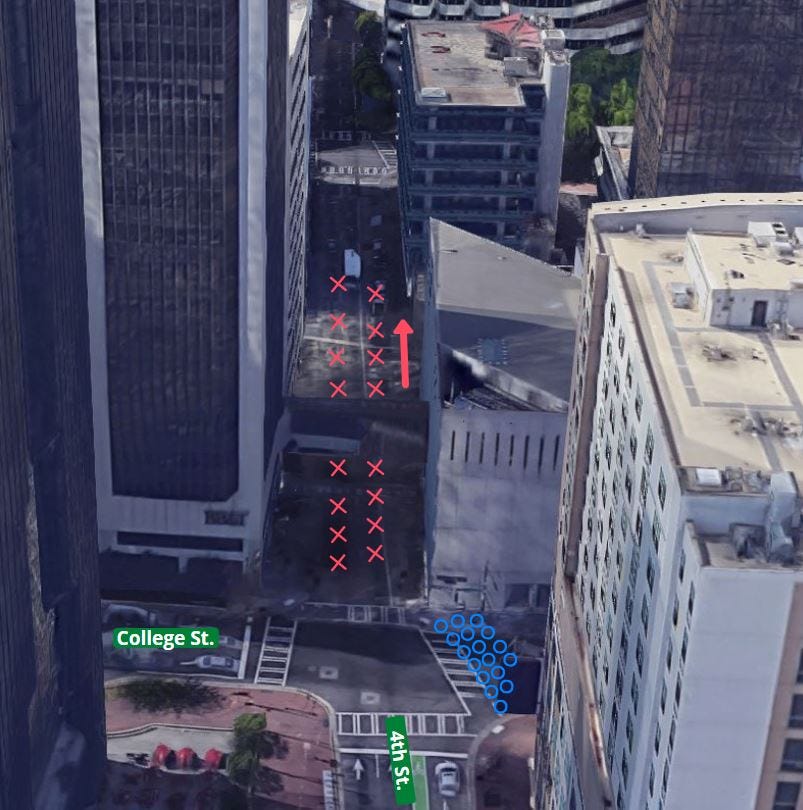
Now all of the protesters were between the two ends of the block.
The entire incident occurs in the next two minutes.
TWO MINUTE WINDOW
Roughly ten seconds after the last protester cleared the intersection — at approximately 9:29:51 p.m. — a second police unit ran into place at the far end of 4th Street, roughly 20 feet ahead of the advancing protesters, as depicted below:
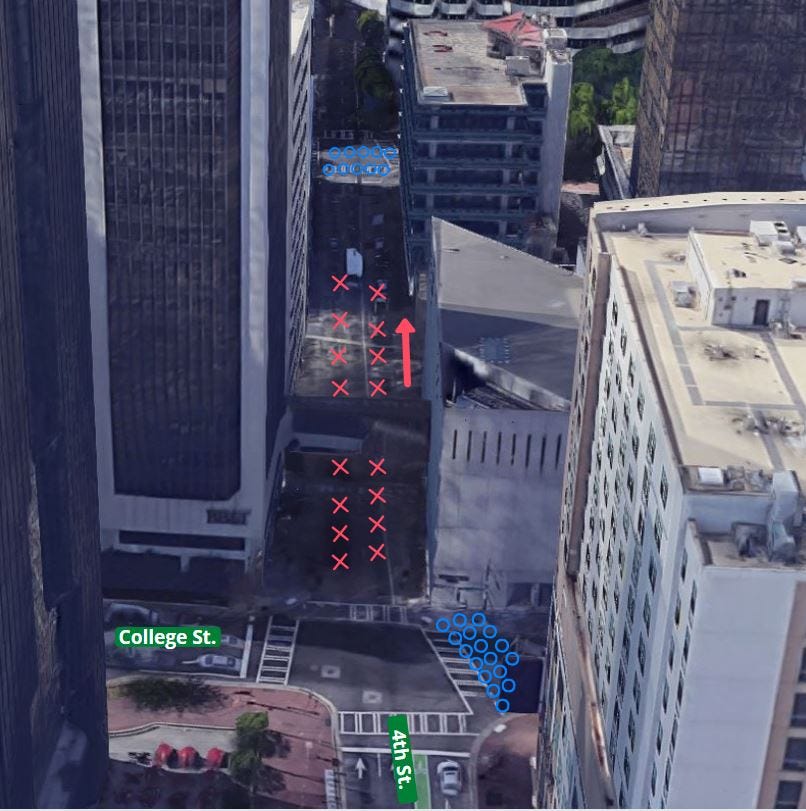
As they ran into place, they immediately detonated a canister of tear gas and a flashbang.
Here is what it looked, sounded, and felt like from the perspective of the protesters as the second police unit quickly appeared in front of them and detonated tear gas and a flashbang:
The upper-right hand corner of the video very briefly shows the officers run into the frame before the video operator turns to run the opposite direction. You can also see a brief flash from the detonation of the tear gas canister. A few seconds later, you can see and hear the detonation of the flashbang. (You can watch the full video, taken by Melody Rogers, here.)
As you can see, the crowd at the front of the march immediately reversed course and began running in the opposite direction, toward the rest of the protesters — and toward the first police unit on the near-side of 4th Street, the group they had all marched past as the crossed the intersection roughly one minute earlier.
The back of the crowd saw the tear gas and the flashbang and came to a halt.
We are now only 10 seconds into our two minute window. Events move quickly now so I’ll use time breaks.
10 seconds later: The first police unit (the ones at the beginning of the block) detonate tear gas on the near-side of 4th Street. They also detonate a flashbang.
15 seconds seconds later: The same officers detonate a second canister of tear gas at the beginning of the block.
10 seconds later: The same officers detonate a third canister of tear gas.
At this point, the near-side of 4th Street is covered in tear gas. The protesters have clouds of tear gas on both sides of them. You can hear the anxiety spike: “We’re trapped in here.”
Here are those events on video:
In the next moment, the protesters become aware that there are multiple officers on the second floor of the parking deck beside them, and that these officers are firing pepper balls.
Currently, there is a disagreement between the protesters and CMPD about whether those officers were firing pepper balls at the protesters or over their heads.
And to be clear, there is no question that at least some pepper balls were fired over the heads of protesters.
Here is a picture of the sign for the parking garage that was across the street from the officers who were firing pepper balls. This photo was taken the day after the incident by Queen City Nerve, as you can see here.
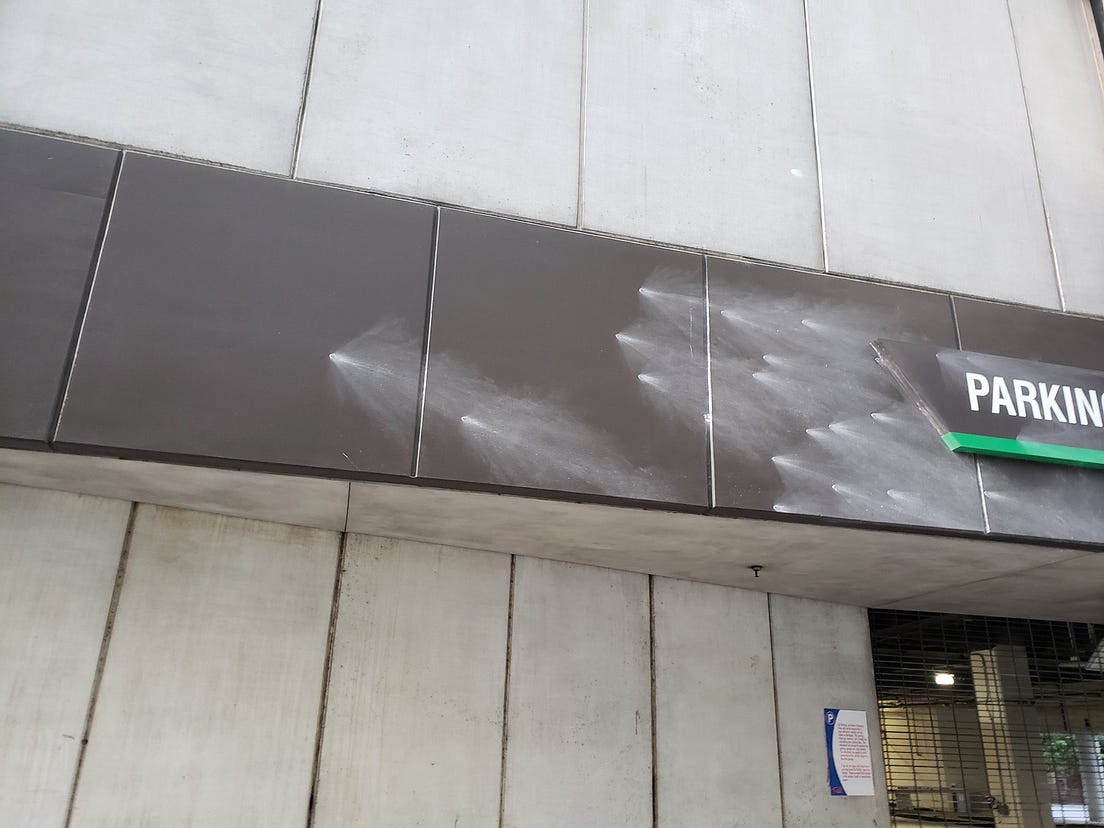
Here is a picture that includes the sign that was hit with pepper balls on the right and the parking garage from which officers were firing from the second floor on the left.
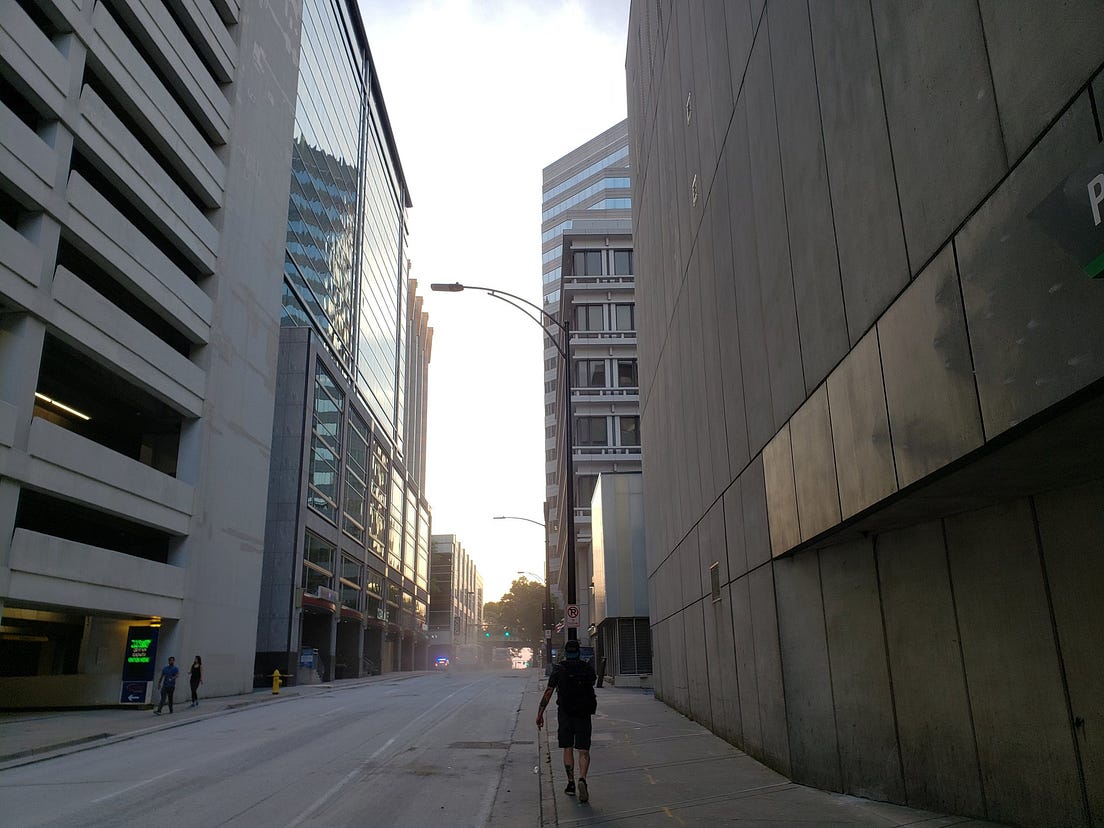
But there is also no question that protesters were shot with pepper balls. Not all the balls were being fired over their heads. There are numerous personal accounts of being hit with balls, but there is also video of a young man who was clearly hit in the face:
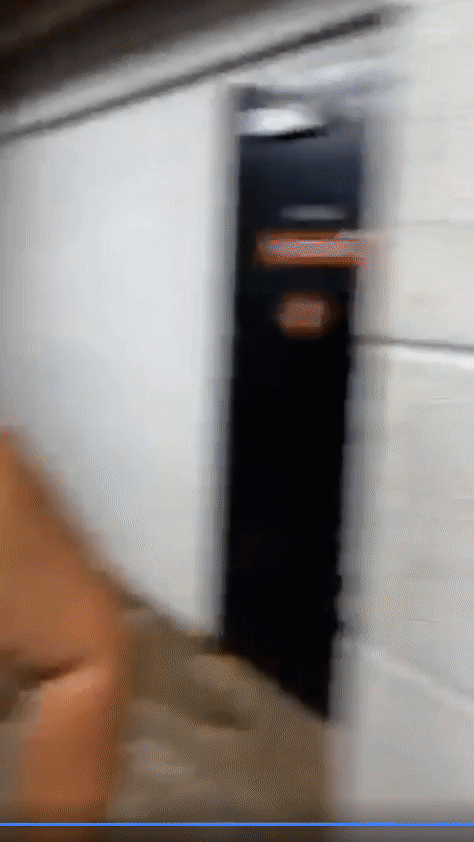
This context is important before watching the next video, because it establishes that protesters were being shot with pepper balls even though you can’t see it in the video. CMPD states that there were officers shooting pepper balls from the ground and from the parking garage, so we know they were coming from multiple directions. CMPD policy is to shoot at the ground or, if necessary, below the waist. But here, it is clear that they were not firing at the ground but at the protesters and that at least one officer fired a shot at eye-level and struck a protester in the face.
Although you can’t see the pepper balls being fired in this video, you can hear them. They are fired from modified paint ball guns, so if you listen you can here the pressurized air release every time the trigger is pulled. You’ll hear it dozens of times.
Here is the rest of the video from the incident. It picks up where the video above leaves off. The protesters are essentially trapped between two walls of tear gas and have had flashbangs used on both sides of them. Now here come the pepper balls, which induce a panic and force them to pry open the gate of a nearby parking garage just enough to crawl underneath. As they escape, you can hear at least five more flashbangs being used and pepper balls being fired at a near continuous rate.
No significant acts followed. That concludes the timeline of the incident.
CONCERNS
We will learn more about this evening from the formal investigations, but we know enough already to draw some conclusions.
- CMPD states that body camera video will show it issued a dispersal order earlier in the evening while the protesters were in a different part of the city. That may be. But if so, it was issued it in a manner that wasn’t heard by the live-stream video of the march, nor by a single protester with whom I spoke. If a dispersal order is going to continue to be the dividing line between “accommodating” a protest and “dispersing” it, then CMPD has an obligation to ensure that dispersal orders are communicated effectively.
- Once a dispersal order is given, that cannot give CMPD an unlimited amount of time to act on the order. If a crowd is ordered to disperse, and CMPD fails to act on the order, and over the next hour the crowd conducts itself lawfully, CMPD cannot then throw the switch, take everyone by surprise, and start tossing flashbangs at an otherwise lawful crowd. If CMPD fails to act on a dispersal order within 10–15 minutes it must either re-evaluate the lawful status of the crowd or, at a minimum, re-convey its dispersal order. One of the things you hear from the protesters who were present for this incident is that they were simply taken completely by surprise. They didn’t think they were doing anything to provoke that kind of highly aggressive response. They weren’t on notice that something like this might be coming and that made the highly aggressive response they faced much more shocking.
- The use of tear gas on both sides of the street — essentially boxing in the protesters — was wrong. From what we’ve heard from CMPD, the detonation of tear gas on the near-end of the street was poorly timed. They state that it was not their intent to box in the protesters. But the video speaks for itself. On the near-side of the street — which is where most of the protesters were clumped together — officers threw three canisters of tear gas over a 30 second period, more than enough time to determine what the likely effect would be. And the placement of the tear gas is also telling. The first canister is on the left-hand side of the street, the second is thrown to the right-hand side, and the third is tossed in the direction of the protesters and in the middle of the street. The plain intent of the officers who were on the ground was to block the entire street with tear gas, which they achieved. Setting aside the fact that boxing in protesters with tear gas serves no tactical purpose (especially when the objective is dispersal), doing so demonstrates a willingness to induce fear and panic for its own sake, not to protect people or property.
- Given that the tear gas had effectively immobilized the crowd, the firing of pepper balls was wrong. Even if procedure had been followed and pepper balls were only fired at their feet, they were largely immobilized by the tear gas. Firing pepper balls could serve no tactical purpose at that point. All it could do was induce fear and panic and create a greater risk of injury as a result. That said, as discussed the video plainly shows that at least one officer fired at eye-level, striking a protester in the face. Whether this ball was fired from the ground or from the parking deck, it was a reckless act that plainly violates CMPD policy.
- The use of pepper balls in this situation was inappropriate, given the immobilization of the crowd — but the use of pepper balls from an elevated position is particularly egregious. Imagine you’re surrounded by tear gas, you’re coughing, people around you are coughing, and then suddenly you realize people above you are firing down. Anyone would panic. Anyone would be terrified. It’s the type of moment that is likely to stick with you for years. And it serves no tactical purpose. It’s only purpose — and its only effect — would be traumatize people. That’s unacceptable. From a tactical standpoint, it will never serve a legitimate purpose to trap a crowd with tear gas and then fire pepper balls from above. There is no scenario in which that approach is necessary to accomplish a legitimate objective.
- Clearly, this was coordinated. It may not have gone completely according to plan, but CMPD had a plan to essentially force an end to this march and they picked 4th Street to execute. Which meant that there were people in charge on the ground. And it should have been very clear to whoever was in charge that protesters had been boxed in with tear gas, which served no tactical purpose. At some point, one of the leaders on the ground should have forcefully intervened, either to tell their officers to stand down or rapidly adjust their approach. But we don’t see that. Instead, we see at least five flashbangs being used on the crowd even after protesters have pried open the garage gate and managed to crawl under it, after they’re basically terrified and in full flight. Presumably, this was not over the objection of the leader on the ground. One of the things we all need to see from the body camera footage is how the leader on the ground reacted in real-time to these events.
- These tactics created an unnecessary risk of injury to those who were present. They also created an unnecessary perception — by the national audience that this incident received — that our city views non-threatening protesters as fair game for a highly aggressive police response.
- CMPD states that at least one officer was assaulted via projectile that evening, although they have not stated that this occurred on 4th Street. CMPD also states that 10 officers have been injured since the start of the protests. Real protesters — citizens who are marching in pursuit of justice and to create real change — know full well that assaulting police officers is both wrong and contrary to their goals, and that’s why you can see them yell at people who throw things at the police. The difficulty is that these protests tend to be lightly organized, at best. Most of the “organization” occurs in making a post to social media that draws a crowd. Prior to social media, the only way to generate a crowd was to organize. Now the organization comes after, if at all. Given the endurance of protest as a political act, modern political organizations — especially those in the space of civil rights and police tactics — need to develop the capacity to staff and lead large-scale protests. And the plan has to run all the way through to the end of the night. Establishing a formal end to a protest at 9:00 p.m. doesn’t mean much. If an organization invites people to a protest, then the same organization should be prepared to staff and lead that protest until people are ready to go home. We can’t abandon our leadership post just because the appointed hour has arrived.
ACTION
This incident was a specific example within a broader moment. As a result, there are specific actions that we should take.
There are roughly three zones of accountability here: CMPD sets tactical policy, City Council sets general limits on that policy, and the state legislature writes laws that apply to the whole state.
I’ve already listed some tactical reforms that CMPD should make coming out of this event. I will tell you that in the preliminary conversations I’ve had with CMPD leadership and other public statements I’ve heard them make recently, I have heard a lot of agreement with some of the points above, particularly 1, 2, and 5. One of the formal reviews for the incident is being conducted by the Center for Domestic Preparedness, which is a federal office under FEMA that focuses on training and best practices. There are going to be significant tactical reforms within CMPD as a result of this incident.
City Council has begun taking steps, including the adoption of the 8 Can’t Wait recommendations. Many of these recommendations are already CMPD policy (for instance, CMPD already bans choke-holds), but one in particular did not exist prior until last week and is of particular importance in light of the killing of George Floyd. CMPD — like all police departments — needs to adopt and train for a duty to intervene. Until last week, CMPD had a “neglect of duty” standard. Now, CMPD has adopted a duty to intervene standard. Here is the new policy language: “Officers will take appropriate and immediate action in any situation in which they know or should have known their failure to act would result in an excessive response to resistance or egregious behavior which shocks the conscience.”
But what we’ve learned is that merely adopting a higher standard is insufficient. That standard must come with sustained training in order to produce the necessary results. Standing up to people when they’re engaged in “egregious behavior which shocks the conscience” can be a real challenge, especially when you work with those people in a rank-structured environment (as I have for 18 years in the army). Without regular training that changes norms and gives people the tools they need, the policy is mere words.
The same is true for most of the 8 Can’t Wait recommendations. Adopting them and actually training to those standards are two different things, and we need the latter. It will be the job of City Council to ensure that training is actually occurring.
As for the state legislature, a group of us are preparing a legislative response to the killing of George Floyd and the clear need to implement serious reform. Our goal is to make those proposals available for your feedback within the next ten days. But I want to focus on one piece that I know is going to be in there, because it relates directly to this incident: We need to reform our laws with respect to the accessibility of body cameras. The state legislature passed a law in this area a few years ago, and it attempted to strike a balance between public access and the privacy concerns of those who are depicted. You can’t simply live-stream all body camera footage because then lots of victims and witnesses would never want to speak to the police. So there needs to be a deliberate process that involves making a request for footage and making sure that all reasonable requests can be granted in a timely manner. But we didn’t get it quite right. We made it too hard for people to view the video, even when law enforcement wants people to see the video (and CMPD made a request to release the body camera footage from this incident the next day). Even City Council hasn’t been able to view the body camera footage yet, and there’s no good reason for that. I will be proposing a reform to our law in this area that I feel will better strike the balance between protection of privacy and serving the public interest. I can also forecast the proposal of a statewide duty to intervene, just as we now have at CMPD.
Personally, I will also actively participate in community discussions on this subject and make myself available to any constituent who has something to say to me about it. To that point, here’s my email address: Jeff.Jackson@ncleg.net. I check it every day. If you have a perspective on this you want to share, I will read anything you have to say and you will get a personal response from me within 48 hours to confirm that I’ve received and read what you sent (unless there’s a hurricane or something in which case I’ll need a little more time). I have learned *a ton* in the last ten days, just from people reaching out, so don’t hesitate.

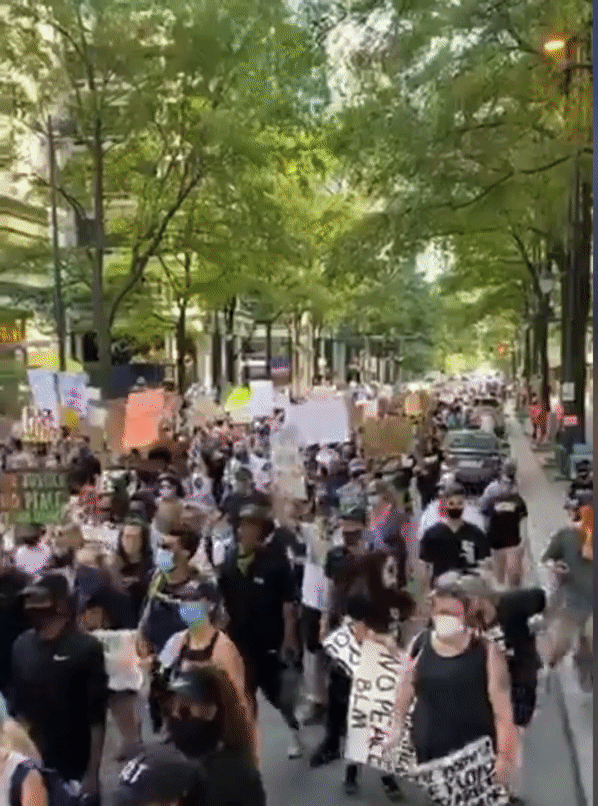
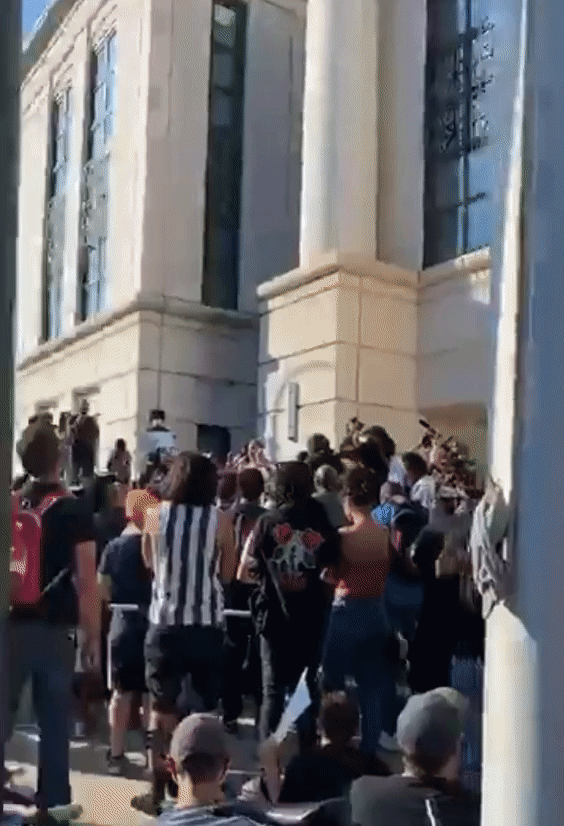
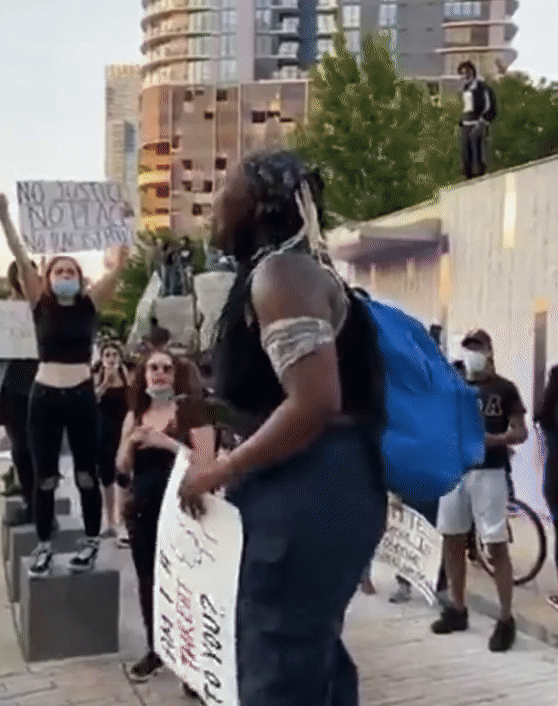
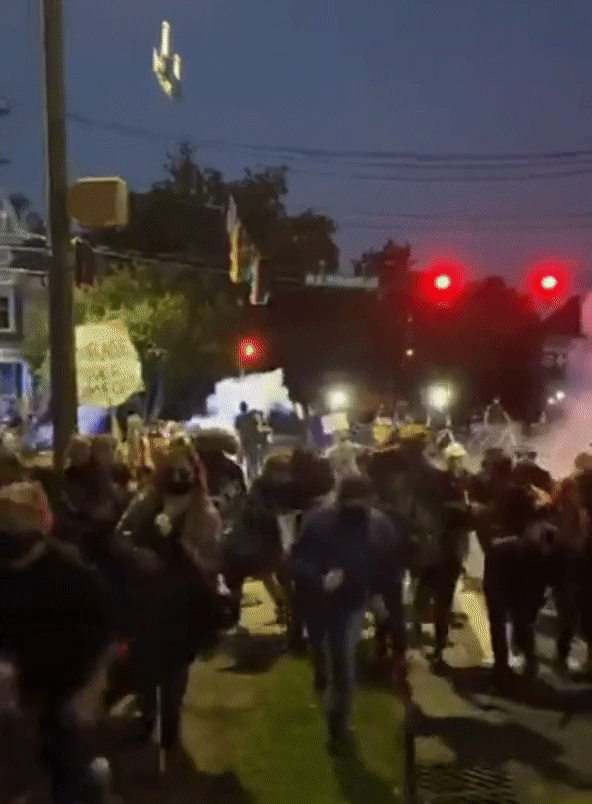

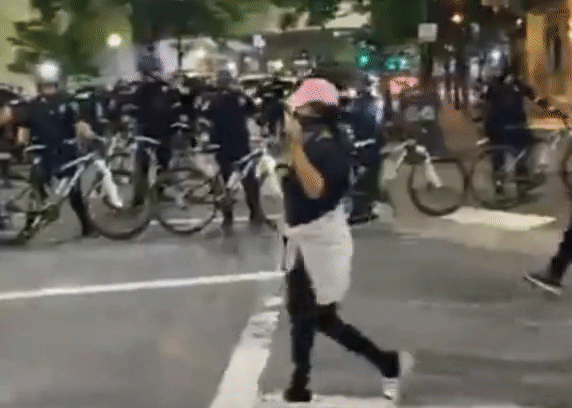




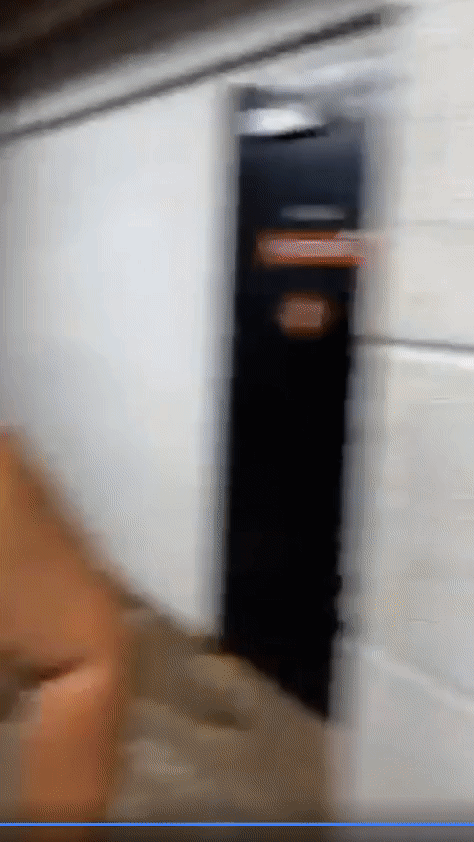
6 comments:
meanwhile, your favorite community sergeant (Richard Nelson) has posted on his Facebook images of himself tagging buildings with spray paint in uniform. What a disgrace for our city. What kind of message does this give to others? Everybody go do your own graffiti. It is cool, the cops are doing it. Oh wait, they are better than us because we get arrested for it. Double standards. Fuq outta here with that shyt.
Go fuck yourself.... nobody gets arrested for that shit
Fuq this place, I’m commissioning in the military active duty
anon 11:29 and 11:31... Say something useful or shut up.
11:54 you can also go fuck yourself... my comment was useful... when was the last time someone in Charlotte got arrested for spray painting something?
A CMPD sergeant tagging buildings is absurd and he should be fired. Regarding the protest issue...It should be assumed it is unlawful because it is not within the stage 2 guidelines. There are more than 25 people and they are not social distancing. The covid numbers are going way up! So I would like to know how its considered lawful in the first place. Please explain. Also, if the RNC was not acceptable, this shouldn't be allowed either. The RNC would have been more than 2 months away and would have helped many of the small businesses that have suffered terribly due to the shutdown. Why doesn't Charlotte government care about this? I know Cooper was the hold up, but Charlotte could have fought for it. They didn't.
Post a Comment